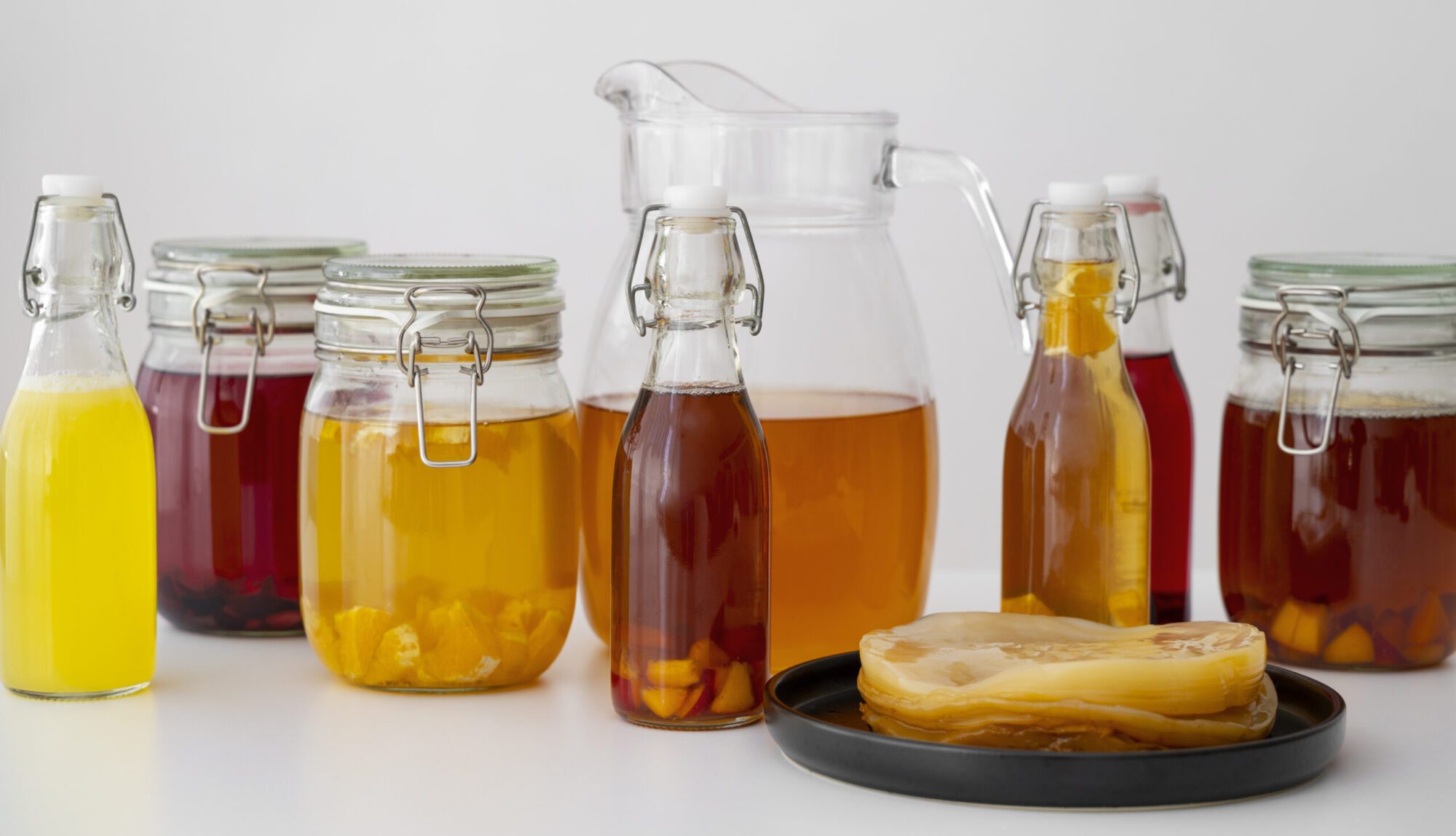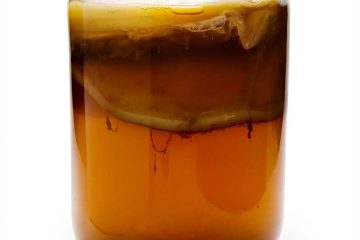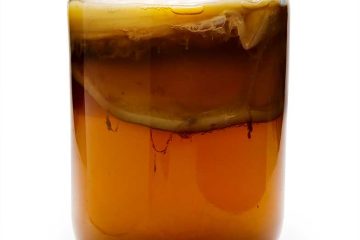The Ultimate Guide to Making Homemade Kombucha Tea

The Ultimate Guide to Making Homemade Kombucha Tea
Kombucha tea has been around for centuries, and it’s gaining popularity as people become more health-conscious and seek natural, nutritious alternatives to sugary, processed beverages. This fermented tea is not only delicious but also has various health benefits, including improving digestion, boosting the immune system, and aiding detoxification. If you’re interested in harnessing the power of kombucha, making it at home is an easy and rewarding endeavor. In this ultimate guide, we’ll cover everything you need to know to start brewing homemade kombucha tea.
What is Kombucha Tea?
Kombucha tea is a fermented beverage made from sweetened black or green tea and a symbiotic culture of bacteria and yeast (SCOBY). The SCOBY is a living organism that looks like a rubbery disc and forms a floating mat on the surface of the liquid during fermentation. As the tea ferments, the SCOBY metabolizes the sugar and produces various acids, enzymes, and vitamins, giving kombucha its unique flavor and health benefits.
The Origins of Kombucha Tea
The origins of kombucha tea are still shrouded in mystery, but it’s believed to have originated in Asia or Russia. The name “kombucha” is said to come from Japan, where it was called “kombucha” or “kocha kinoko,” meaning “tea fungus” or “tea mushroom.” It then spread to China, Russia, and eventually to Europe and the Americas.
Health Benefits of Kombucha Tea
Kombucha tea is renowned for its potential health benefits, although more research is needed to fully understand its effects. Some of the potential health benefits associated with kombucha tea include:
Improved digestion: The probiotics produced during fermentation may help maintain a healthy balance of gut bacteria, aiding digestion and nutrient absorption.
Detoxification: Kombucha tea may support liver function and aid the body in eliminating toxins.
Boosted immune system: The beneficial acids and antioxidants found in kombucha tea may help strengthen the immune system.
Weight management: Some animal studies suggest that kombucha tea may aid in weight loss by regulating metabolism and reducing the absorption of dietary fat.
Potential Risks of Kombucha Tea
While kombucha tea offers numerous potential health benefits, it’s important to be aware of potential risks associated with home brewing:
Contamination: The acidity and low pH of kombucha tea inhibit the growth of harmful bacteria, but contamination can still occur if the brewing process is not properly managed.
Alcohol content: Kombucha tea naturally contains a small amount of alcohol, which can increase over time during the fermentation process. It’s important to monitor the alcohol content, especially for individuals who are sensitive to alcohol.
Allergic reactions: Allergic reactions to kombucha tea are rare but possible. People with sensitivities or allergies to certain molds or yeasts should exercise caution.
Starting Your Homemade Kombucha Journey
Now that you understand the basics of kombucha tea, you might be eager to start brewing your own at home. Not only is making kombucha tea a fun and rewarding experience, but it also allows you to customize the flavor and strength of the tea to your liking. Here is the ultimate guide to making homemade kombucha tea:
Ingredients and Equipment
Before starting the brewing process, it’s essential to gather the necessary ingredients and equipment. Here’s what you’ll need:
Ingredients:
Filtered water
Black or green tea
Granulated sugar
SCOBY (obtained from a reputable source or from a previous batch of kombucha tea)
Starter tea (previously brewed unflavored kombucha)
Optional flavorings (fruit, herbs, spices)
Equipment:
Large glass jar (1-gallon capacity)
Cloth or coffee filter
Rubber band
Fermentation vessel
pH strips or pH meter
Bottles for bottling the finished kombucha
Preparing Your Kombucha Tea
1. Start by preparing the tea base. Bring 4 cups of water to a boil and remove it from the heat. Add 4-6 tea bags or 4-6 teaspoons of loose tea to the hot water and let it steep for 5-7 minutes.
2. Remove the tea bags or strain the loose tea, and stir in 1 cup of sugar until it completely dissolves. Allow the sweetened tea to cool to room temperature, then pour it into a clean, 1-gallon glass jar.
3. Add the SCOBY and starter tea to the jar. The starter tea is approximately 10-15% of the total volume of the brewing vessel and helps acidify the tea, lowering the pH and creating a favorable environment for the SCOBY.
4. Cover the jar with a cloth or coffee filter and secure it with a rubber band to prevent dust or insects from entering while allowing air circulation.
Fermentation and Maintenance
Once you’ve prepared your kombucha tea, it’s time for the fermentation process. Here are the steps to ferment and maintain your kombucha tea:
1. Place the jar in a warm, dark area, such as a pantry or cupboard, that maintains a consistent temperature between 75-85°F. Avoid placing it in direct sunlight or areas with temperature fluctuations.
2. Allow the kombucha tea to ferment for 7-14 days, depending on the ambient temperature and your desired level of acidity. Check the taste and pH of the kombucha tea periodically to determine when it’s ready.
3. Once the kombucha tea has reached your desired level of acidity, remove the SCOBY and 10-15% of the liquid (starter tea) and set it aside for future batches. The rest of the kombucha can now be flavored, bottled, and refrigerated.
Flavoring and Bottling Your Kombucha Tea
Flavoring your kombucha tea is a fun and creative process that allows you to customize the taste and experience. To flavor and bottle your kombucha tea, follow these steps:
1. Remove the SCOBY from the fermented tea and set it aside.
2. If you wish to flavor your kombucha tea, add fruit, herbs, or spices to the fermented tea. Common flavorings include ginger, berries, citrus, and mint. This is your chance to get creative and experiment with different flavors.
3. Once you’ve added your desired flavorings, it’s time to bottle the kombucha tea. Using a funnel, carefully pour the flavored kombucha tea into clean, airtight bottles, leaving a few inches of headspace at the top of each bottle.
4. Seal the bottles and allow them to sit at room temperature for an additional 1-3 days to carbonate. This secondary fermentation process will create effervescence and enhance the flavor of the kombucha tea.
5. After the secondary fermentation, refrigerate the bottled kombucha tea to slow down the carbonation and maintain its freshness.
Tips for Success
As you embark on your homemade kombucha journey, here are some tips for a successful brewing experience:
Use filtered water: Chlorine and other chemicals commonly found in tap water can hinder the fermentation process. Use filtered or dechlorinated water for brewing kombucha tea.
Maintain a clean environment: Ensure that all equipment and surfaces are clean and sanitized to prevent contamination of the brewing environment.
Avoid metal contact: Metal can react with the acidic nature of kombucha tea and harm the SCOBY. Use glass, plastic, or other non-reactive materials for brewing and storage.
Monitor the fermentation process: Taste the kombucha tea regularly to track its progress and determine the optimal level of acidity for your preference.
Experiment with flavors: Don’t be afraid to get creative with flavorings and ingredients. Kombucha tea is incredibly versatile and can be flavored in countless ways to suit your taste.
Conclusion
Brewing homemade kombucha tea is a delightful and rewarding process that yields a delicious and nutritious beverage. With some patience and careful attention to detail, you can enjoy the health benefits and unique flavors of kombucha tea made in the comfort of your own home. Whether you’re an experienced homebrewer or new to the world of fermented beverages, making kombucha tea is a satisfying and joyful pursuit that can be enjoyed by all. So, roll up your sleeves, gather your ingredients, and embark on the remarkable journey of brewing your very own homemade kombucha tea. Cheers to good health and delightful flavors!
[elementor-template id=”430″]
[elementor-template id=”433″]




0 Comments